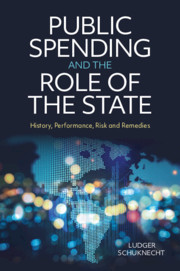Book contents
- Public Spending and the Role of the State
- Public Spending and the Role of the State
- Copyright page
- Dedication
- Contents
- Figures
- Tables
- Preface
- Acknowledgements
- Acronyms and Abbreviations
- Introduction
- Part I The Growth of Government
- Part II Value for Money
- Part III Fiscal Risks
- 7 Social Expenditure and the Risk of ‘Social Dominance’
- 8 Fiscal–Financial Risks 1
- 9 Fiscal–Financial Risks 2
- Part IV Remedies
- Table of Data Sources
- Bibliography
- Index
9 - Fiscal–Financial Risks 2
Bank, Shadow Bank, Central Bank and International Channels
from Part III - Fiscal Risks
Published online by Cambridge University Press: 30 October 2020
- Public Spending and the Role of the State
- Public Spending and the Role of the State
- Copyright page
- Dedication
- Contents
- Figures
- Tables
- Preface
- Acknowledgements
- Acronyms and Abbreviations
- Introduction
- Part I The Growth of Government
- Part II Value for Money
- Part III Fiscal Risks
- 7 Social Expenditure and the Risk of ‘Social Dominance’
- 8 Fiscal–Financial Risks 1
- 9 Fiscal–Financial Risks 2
- Part IV Remedies
- Table of Data Sources
- Bibliography
- Index
Summary
This chapter completes the discussion on fiscal–financial risks and looks at banks, shadow banks, central banks and international linkages.Banks have increased their resilience considerably over the past decade, supported by the international regulatory agenda. However, global indebtedness has increased further and bank balance sheets are often loaded with risky public and private credit. Moreover, there are fiscal risks from market-based finance: highly priced, low-quality credit held partly by a run-prone asset management industry, an under-funded pension industry and large derivative clearing houses. Central banks face risks from large asset holdings. International credit is very high and could transmit problems across borders. International safety nets have grown but so have demands for international support.Given record debt and debt increases, and our lack of knowledge and experience of how fiscal–financial risks will unfold in the future, building resilience is of the highest priority. This vindicates constraints on deficit and debt, such as the Maastricht limits and the regulatory agenda for the financial sector, and it provides a further argument for lean and efficient government.
Keywords
- Type
- Chapter
- Information
- Public Spending and the Role of the StateHistory, Performance, Risk and Remedies, pp. 204 - 232Publisher: Cambridge University PressPrint publication year: 2020

